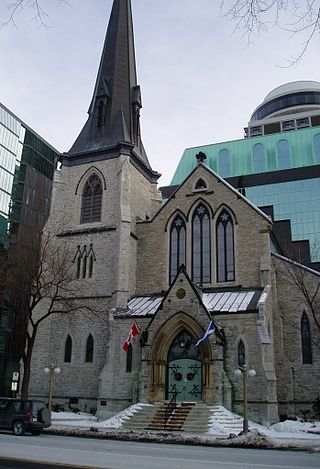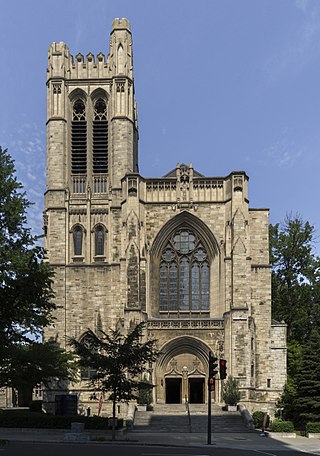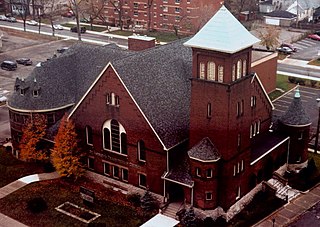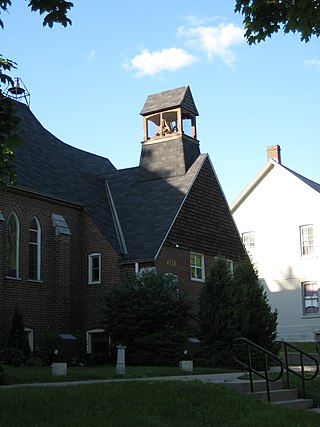
Deer Park is a neighbourhood in Toronto, Ontario, Canada. It is centered on the intersection of Yonge Street and St. Clair Avenue and its boundaries are the Vale of Avoca section of Rosedale ravine in the east, Farnham Avenue and Jackes Avenue in the south, Avenue Road and Oriole Parkway in the west, the Beltline Trail in the north on the west side of Yonge Street, and Glen Elm Avenue in the north on the east side of Yonge Street. For the purposes of social policy analysis and research, the Toronto government’s Social Development & Administration division includes Deer Park within the City of Toronto's official "Rosedale-Moore Park" and "Yonge-St.Clair" neighbourhood profiles. The neighbourhood is in Ward 22, represented by Councillor Josh Matlow at Toronto City Council.

St. Andrew's Presbyterian Church is the oldest Presbyterian church in Ottawa, Ontario, Canada.

The Presbyterian Church in Canada is a Presbyterian denomination, serving in Canada under this name since 1875. The United Church of Canada claimed the right to the name from 1925 to 1939. According to the Canada 2001 Census 409,830 Canadians identify themselves as Presbyterian, that is, 1.4 percent of the population.

Knox Presbyterian Church is a Presbyterian Church in Ottawa, Ontario, Canada. It is named after John Knox, a founder of Presbyterianism in Scotland.

Thomas Baker McQuesten was a politician in Ontario, Canada. He was a Liberal member of the Legislative Assembly of Ontario from 1934 to 1943 who represented the riding of Hamilton—Wentworth. He served as a cabinet minister in the governments of Mitchell Hepburn and Gordon Conant.

St. Giles Presbyterian Church is a member of the Presbyterian Church in Canada located in Ottawa, Ontario, Canada. It was formed in 1925 by a minority group from Glebe Presbyterian, and a few other congregations, that did not support the vote to enter the United Church of Canada.

Knox College is a postgraduate theological college of the University of Toronto in Toronto, Ontario, Canada. It was founded in 1844 as part of a schism movement in the Church of Scotland following the Disruption of 1843. Knox is affiliated with the Presbyterian Church in Canada and confers doctoral degrees as a member school of the Toronto School of Theology.

St. Andrew's Church is a historic Presbyterian church located at the corner of King Street West and Simcoe Street in the city's downtown core of Toronto, Ontario, Canada. It was designed by William George Storm in the Romanesque Revival style and completed in 1876.

Knox Presbyterian Church is a Presbyterian church in downtown Toronto, Ontario, Canada.

The Church of Saint Andrew and St Paul is a Presbyterian church in downtown Montreal, Quebec, Canada. It is located at 3415 Redpath Street, on the corner of Sherbrooke Street. It is in close proximity to the Golden Square Mile, the Montreal Museum of Fine Arts, Concordia University as well as the Guy-Concordia Metro station.
St. James-Bond United Church, at 1066 Avenue Road in Toronto, Ontario, was a United Church of Canada congregation from 1928 to 2005, when it merged with Fairlawn Heights United Church in the Yonge Street and Lawrence Avenue area. The "St. James-Bond" name derived from the merger of St. James Square Presbyterian Church with Bond Street Congregational Church in 1928. Prior to the merger, they were separate congregations downtown, of the Presbyterian and Congregational traditions respectively.

St. Andrew's Presbyterian Church, is a Presbyterian Church in Canada congregation in downtown Windsor, Ontario, Canada. The congregation dates back to 1857, and at one time, was the largest congregation by membership within the Presbyterian Church in Canada (PCC).

John MacIntosh Lyle was an Irish-Canadian architect, designer, urban planner, and teacher active in the late 19th century and into the first half of the 20th century. He was a leading Canadian architect in the Beaux Arts style and was involved in the City Beautiful movement in several Canadian cities. In the 1920s, he worked to develop his vision of a uniquely Canadian style of architecture.

Deer Park United Church is the name of a United Church of Canada congregation, and also the name of this congregation's former church building at 129 St. Clair Avenue West in the Deer Park neighbourhood of Toronto, Ontario, Canada. It was one of two United Church of Canada buildings in the area and along St. Clair Avenue, the other being Timothy Eaton Memorial Church.

Wesley Mimico United Church is a church in Toronto, Ontario, Canada. It is located in the neighbourhood of Mimico in the former city of Etobicoke. The church was created by the union of the former Wesley Methodist Church, Mimico and St. Paul's Presbyterian Church in 1927, of which the Methodist church was the larger partner.

The Wharf Street Congregational Church was a Congregational church built in 1860 on the corner of Wharf Street and Adelaide Street, Brisbane, Queensland, Australia. The church was demolished in 1928. It was the first Congregational church in Brisbane.

Knox-Metropolitan United Church stands on Lorne Street at Victoria Avenue across from Victoria Park in downtown Regina, Saskatchewan, Canada. It is the current manifestation of Presbyterian and Methodist congregations that date back to "worship services in both traditions…in 1882."

Knox Presbyterian Church is located at 4156 Sheppard Avenue East in the Agincourt neighbourhood of Toronto, Ontario, Canada.

Emmanuel United Church is a church located in the downtown core of Peterborough, Ontario, Canada. Originally Methodist, since 1925 it has belonged to the United Church of Canada. The church was built between 1873 and 1875, with the tower being completed in 1891, and was designed by Henry Langley in the Gothic Revival style. It is designated under Part IV of the Ontario Heritage Act by the City of Peterborough By-Law 1990-204 as being of cultural heritage value or interest.

Rosedale United Church is a United Church of Canada church in Toronto, Ontario. It is located at 159 Roxborough Drive in the city's Rosedale neighbourhood.























